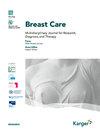影响乳腺癌根治性手术后患者肩部活动障碍的因素
IF 2.1
4区 医学
Q2 OBSTETRICS & GYNECOLOGY
引用次数: 0
摘要
摘要简介:探讨乳腺癌根治性手术后放疗中肩关节活动度受损患者疼痛、握力、冈上肌厚度等影响肩关节活动度的因素。方法:本研究纳入165例术后3个月内化疗期间肩关节活动障碍的女性单侧乳腺癌患者。临床检查包括肩部最大活动范围(屈、伸、外展、内收、外旋和内旋)、疼痛评分(视觉模拟量表[VAS])、握力和棘上肌厚度。结果:肩关节外展时,冈上肌厚度在90°时最大,在0°时最小,在60°时高于30°(p < 0.01)。影响肩关节主动屈伸的因素为VAS评分、体重、握力、脊上肌收缩率(R2=0.295),影响肩关节主动外展的因素为VAS评分、体重、握力、脊上肌厚度(下垂位)、脊上肌收缩率(R2=0.295)。影响肩关节外旋主动运动的因素有年龄、VAS评分、体重、握力、脊上肌厚度(下垂位)(R2=0.258)。对肩关节伸、内收或内旋的多重线性回归没有明显的结果。结论:疼痛、体重、握力、冈上肌厚度、冈上肌膨胀性是影响肩关节屈曲、外展、外旋的主要因素。冈上肌的厚度和收缩率可以作为评估肩关节功能障碍的新指标。本文章由计算机程序翻译,如有差异,请以英文原文为准。
The factors influencing shoulder mobility disorders in patients after radical breast cancer surgery
Abstract Introduction: To investigate the factors influencing shoulder mobility in terms of pain, grip strength, and supraspinatus muscle thickness in patients with impaired shoulder mobility during radiotherapy after radical breast cancer surgery. Methods: This study included 165 female patients with unilateral breast cancer who had shoulder joint mobility disorders during chemotherapy within 3 months after surgery. The clinical examination included the maximum active range of motion of the shoulder (flexion, extension, abduction, adduction, external rotation, and internal rotation), pain score (visual analog scale [VAS]), grip strength, and supraspinatus muscle thickness. Results: During shoulder abduction, supraspinatus muscle thickness was greatest at 90°, lowest at 0°, and higher at 60° than at 30° (p<0.01). The factors influencing the active movement of shoulder flexion were the VAS score, body weight, grip strength, and supraspinatus contraction rate (R2=0.295), while the factors influencing active shoulder abduction were the VAS score, body weight, grip strength, supraspinatus muscle thickness (drooping position), and supraspinatus contraction rate (R2=0.295). Moreover, the factors influencing the active movement of shoulder external rotation were age, VAS score, body weight, grip strength, and supraspinatus muscle thickness (drooping position) (R2=0.258). There were no intentional results from multiple linear regressions for shoulder extension, adduction, or internal rotation. Conclusion: Pain, weight, grip strength, supraspinatus muscle thickness, and supraspinatus distensibility are the main factors affecting shoulder flexion, abduction, and external rotation. In addition, supraspinatus muscle thickness and contraction rate may be a new index for assessing shoulder dysfunction.
求助全文
通过发布文献求助,成功后即可免费获取论文全文。
去求助
来源期刊

Breast Care
医学-妇产科学
CiteScore
4.40
自引率
4.80%
发文量
45
审稿时长
6-12 weeks
期刊介绍:
''Breast Care'' is a peer-reviewed scientific journal that covers all aspects of breast biology. Due to its interdisciplinary perspective, it encompasses articles on basic research, prevention, diagnosis, and treatment of malignant diseases of the breast. In addition to presenting current developments in clinical research, the scope of clinical practice is broadened by including articles on relevant legal, financial and economic issues.
 求助内容:
求助内容: 应助结果提醒方式:
应助结果提醒方式:


